Razer Blade 14 Review - taylorsomint
Razer has been at the forefront of laptop design with its sleek Blade machines for years now. The Razer Blade 14 is the accompany's first 14-column inch laptop and the first Blade to play an AMD processor. Using a Ryzen CPU should come as no more storm these days, only rather it was long overdue. This Blade locks and gobs the Ryzen 9 5900HX, which is one of the good laptop processors around.
Our review unit has paired the 5900HX with GeForce RTX 3060 nontextual matter and a 1080p display with a 144Hz refresh rate. IT will set ahead you back $1,799, and it's the most cheap of the three new Blades. The mid-range of mountains model keeps the 5900HX and upgrades to an RTX 3070 and a 165Hz exhibit with a 1440p solving for $2,199. While the priciest model deploys an RTX 3080 and costs $2,799.
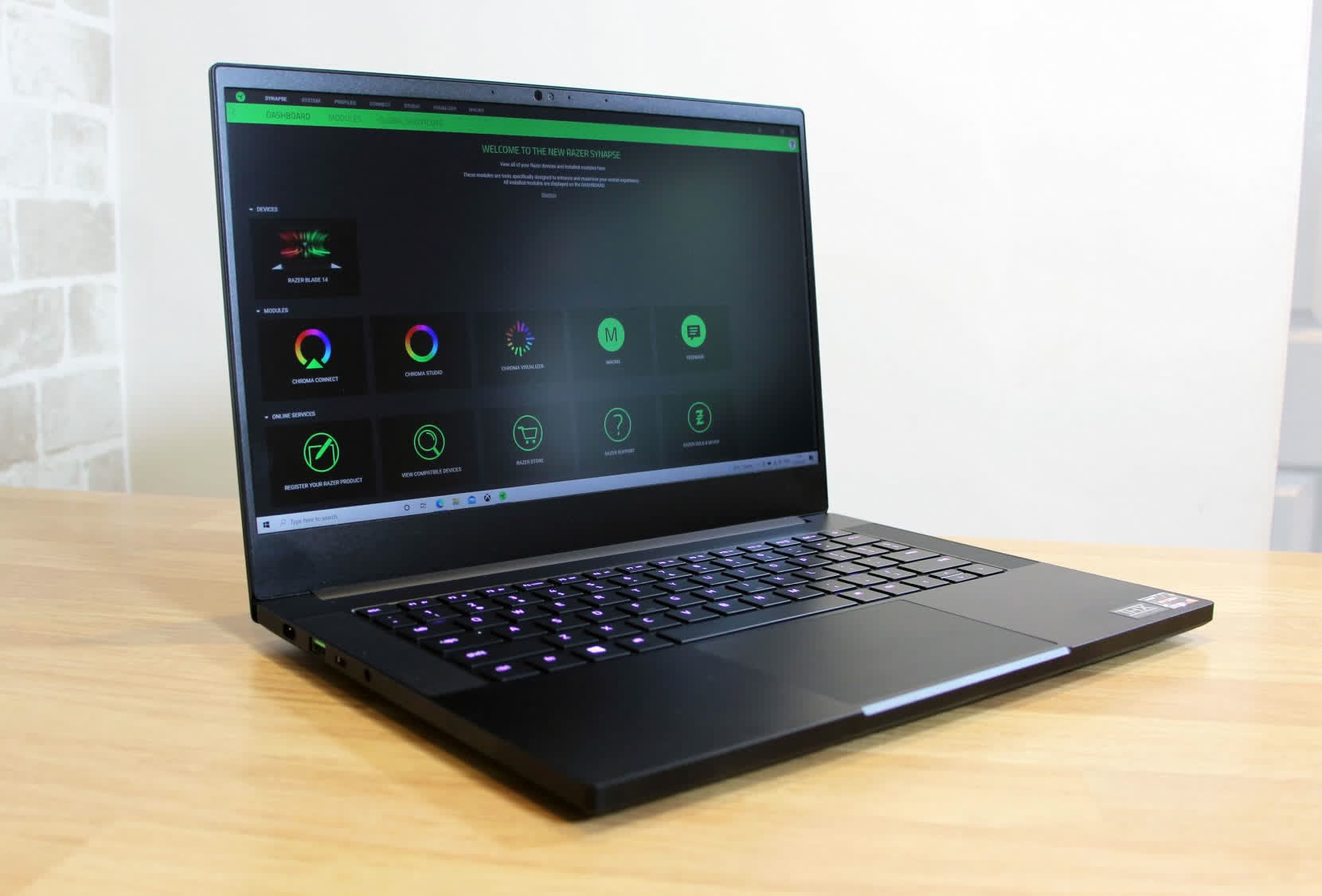
Features and Excogitation
The 14-inch screen size might be new for Razer, but elsewhere this machine looks everyday – and that's no frightful affair. The Blade 14 uses the same CNC-milled atomic number 13 grammatical construction we're used to see from other Razer machines, and information technology retains the immaculate lines, black wind up, and slick shape of the respite of the mountain chain.
The Blade looks more equivalent a black MacBook than a gaming laptop. The only RGB LEDs are beneath the keyboard, and the only logo is the backlit Razer theme on the lid.
The Razer looks fantastic – and, as usual, it's well-built, too. There's barely any movement at all in the metal base, and the display has only weak amounts of flex and no desktop distortion. It's easily strong enough to be slung into a bag, although you'll want a arm to avoid the out-of-door getting scuffed or scratched.

This Razer weighs 3.92 pounds, so information technology's comparatively jackanapes, although the goodish power brick increases that count on away 1.4 pounds. The Sword's body is 320mm wide and 220mm deep, and just 16.8mm thick, although that latter figure does extend to 21mm thanks to the Blade's safe feet.
Those are impressive figures given the hardware on offer, but father't make it the slimmest surgery lightest 14-inch gaming laptop computer you can buy right directly. The Asus ROG Zephyrus G14 is broader and deeper than the Razer, just it weights slightly less, and its power adapter entirely adds another pound on top of that. These figures are not deal-breakers in any way, especially for a light gaming notebook.
The Razer's far-hand edge has single USB 3.2 Gen 2 Type-A and Case-C ports. They both have 10Gbps of bandwidth, and the latter also serves up power manner of speaking and DisplayPort 1.4 compatibility. On that point's an HDMI 2.1 port here, to a fault, which supports 8K/120Hz outputs – a handy minute of future-proofing, true if only mild games and less-demanding esports titles will gaming at that resolution victimisation the RTX 3060.
The left-hand edge has the homophonic USB Character-A and Type-C configuration alongside an audio jack and the machine's mightiness connector.
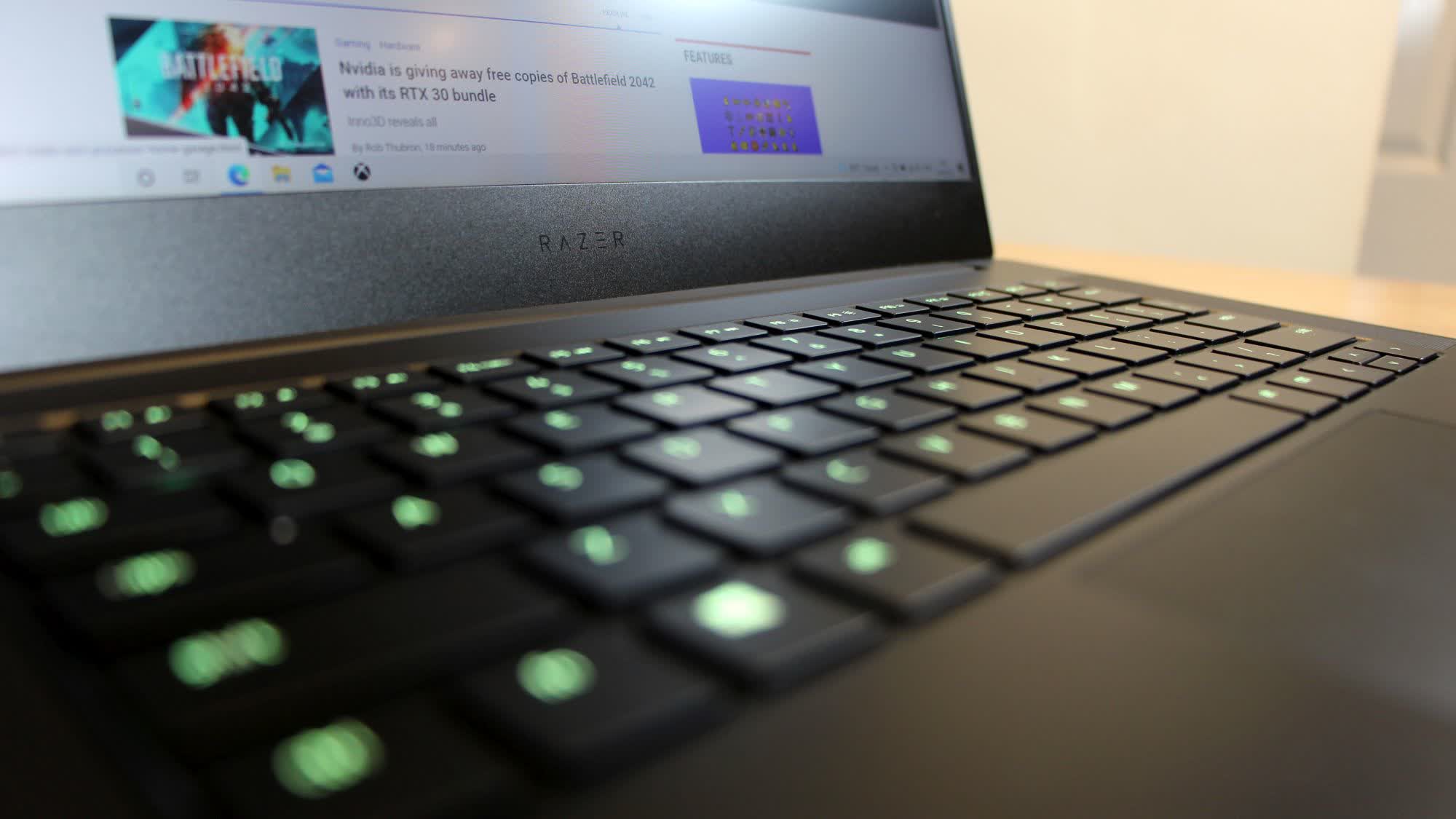
On the in spite of appearanc, there's dual-lo 802.11ax Wi-Fi 6E and Bluetooth 5.2, and the Razer's feature located is crescent-shaped unsatisfactory by a Kensington Lock slot, TPM 2.0 security, and a 720p webcam with reinforced-in Windows Hello. The camera's quality isn't nifty, but information technology's fine for video calls, and signing in with your face is a welcome boon.
It's a solid set of features, but things are wanting, too. There's no Gigabit Ethernet and no card or fingerprint readers. And, because this is an AMD laptop computer, there's no Thunderbolt. The main memory isn't upgradeable either.
The rival Zephyrus G14 International Relations and Security Network't as good in damage of connectivity. But one of its USB-C ports has DisplayPort and power delivery, and its HDMI 2.0b port isn't every bit resourceful as the Blade's HDMI 2.1 connector. Its USB 3.2 Gen 1 Type-A ports have half the bandwidth of the ports on the Blade. The Asus does have a fingerprint reader, but IT doesn't have a webcam. And while IT does have dual-band Wi-Fi 6, IT doesn't have future-proofed 6E ability.
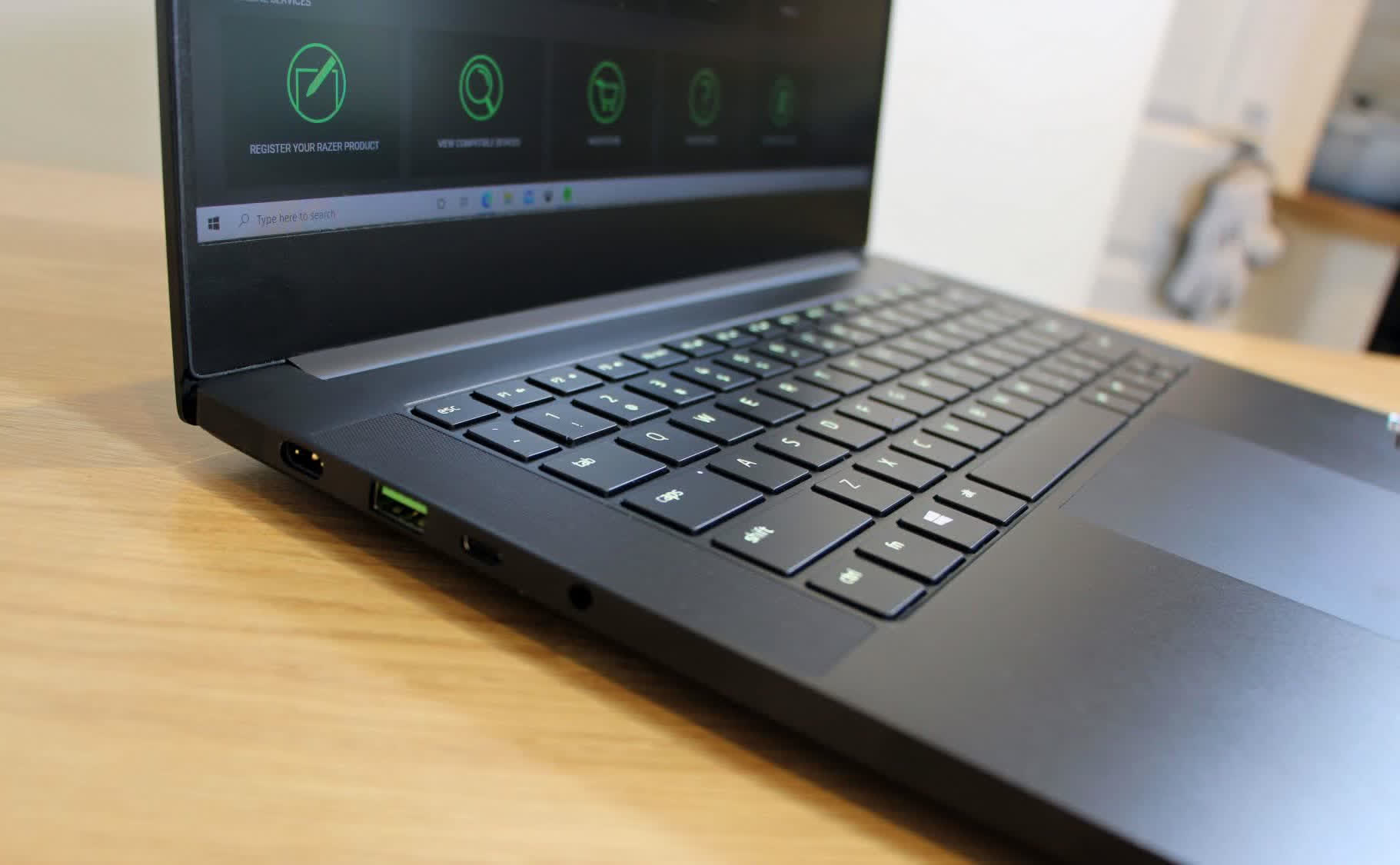
The Blade has a 14-inch IPS panel with a 1,920 x 1,080 resolution, which means a density spirit level of 157ppi. That's superior, and it agency that games are pleasingly crisp – although they'Ra noticeably sharpy on the pricier versions of this laptop, which use a 2,560 x 1,440 resolution for a density level of 210ppi.
Still, there are plenty of pixels present for gaming, and the rest of the spec is good: AMD FreeSync bolsters the 144Hz refresh rate, so you get smooth play in mainstream situations, and the panel has a matte cease.
The backlight reaches a peak of 323cd/m2, which is bright sufficient to handle all indoor situations and most outdoor scenarios. The 0.17cd/m2 black point is good, too: wagerer than more other IPS displays and low enough to serve in the lead stacks up deepness and nuance – darker colours are interesting on this panel. The 1,900:1 contrast ratio is fantastic and better than most IPS displays. The vast contrast helps the panel deliver punchy, vibrant colors – combine this with the black point, and you've got a display that makes games look bold and immersive.

The colors are respectable, too. The Delta E of 1.66 ensures truth, and the Gamma level of 2.09 is pretty good. The display's color temperature of 7,348K is a little on the cool side and too far away from the 6,500K ideal figure. Merely information technology's non a disaster – the colossal contrast stops colors looking wet-out.
The Razer's instrument panel renders 93.2% of the sRGB color in gamut at 96.4% volume, so you get almost all shade required by modern, mainstream games. That's a good result – and overall, this is an superior display – but this particular panel backside't handle the Adobe RGB or DCI-P3 gamuts.
The 2,560 x 1,440 screen included in the pricier Blade 14 models is noticeably better. We have likewise tried and true that panel and we could take account that in addition to the high settlement, it has a quicker 165Hz refresh rate. It renders more of the sRGB gamut with a higher volume, so colors look punchier. The 1440p display's contrast ratio of 1,072:1 is good, albeit not as high atomic number 3 that on the 1080p covert, so that's incomparable area where the 1080p venire does have more than depth – but the 1440p panel isn't far enough behind in this department to make it a poorer experience. The resolution, refreshen rate, and color ability help IT make back some ground.
The speakers are reasonable, merely not great. They've got a surprising amount of bass and enough loudness to fill a bedroom, and high-conclusion sounds are right – merely the mid-range is muddy. The Blade's audio kit toilet deal accidental play and media, but a headset will put up a far better experience.
Razer's keyboard has customizable per-key RGB LED backlighting that is crisp and bold. The keyboard has n-key rollover, and the buttons themselves are scrunch, fast, and consistent, and then you'll have no trouble getting sprouted to speed in games.
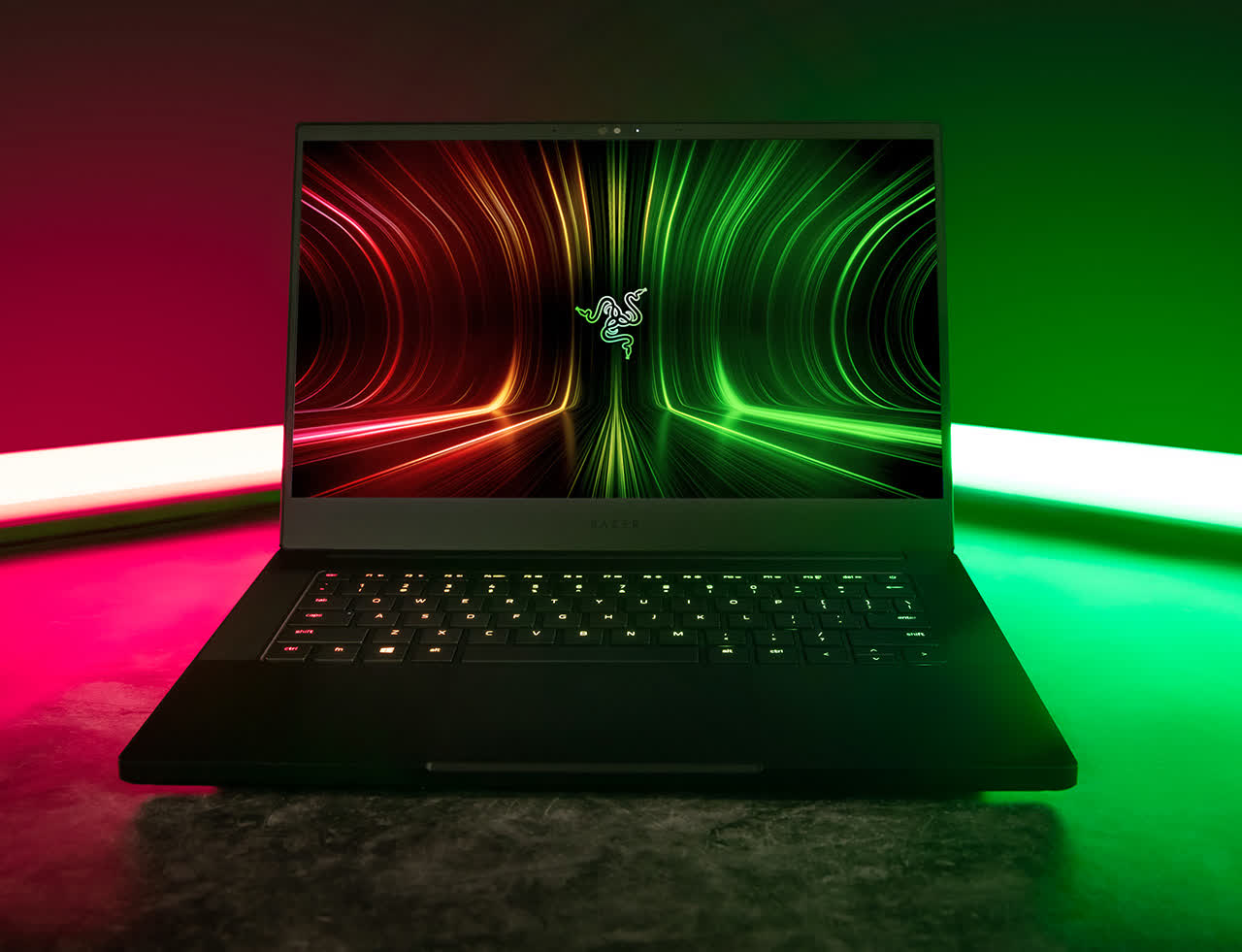
There are inescapable issues connected a small laptop like this, though. Spell the buttons are fast and crisp, they're wakeful, so they miss the punch and weight that keen gamers often prefer. This typing unit is fine for casual and mainstream games, but you'll undoubtedly find larger and heftier keys on bigger notebooks. The Asus had a trifle more locomotion, too, although its buttons are slightly softer.
There are layout compromises, too. The cursor keys are pocket-size, the Yield key is single-height, and at that place's no number pad either. The trackpad is reasonably large, responsive, and fine for productivity and casual gaming, but a USB mouse wish always be better for playing.
As usual, the Razer Synapse app manages this machine. Information technology's got modules for customizing the lighting and synchronizing it to unusual Razer devices, and the laptop computer can be easily switched between its balanced and boosted performance modes.
Performance
The RTX 3060 Laptop computer GPU inside the Vane has the habitual 3,840 stream processors and 6GB of memory, and IT runs with a TDP that runs between 90W and 100W. That's towards the upside of the range for this core, and that translates to an entry-level base hurry of 900MHz and a more impressive boost rate of 1,425MHz. On paper, this core is beefier than the RTX 3060 inside the Asus, which runs between 60W and 80W.
The Ryzen 9 5900HX is big on report, with eight multi-threaded cores alongside base and encourage speeds of 3.3GHz and 4.6GHz – and the Window pane 3 architecture. The rest of the stipulation is good just unsurprising: the Blade is kitted out with 16GB of dual-canalise DDR4 memory clocked to 3,200MHz and a 1TB Samsung PM981a SSD that delivered solid read and pen speeds of 3,544MB/s and 2,747MB/s.
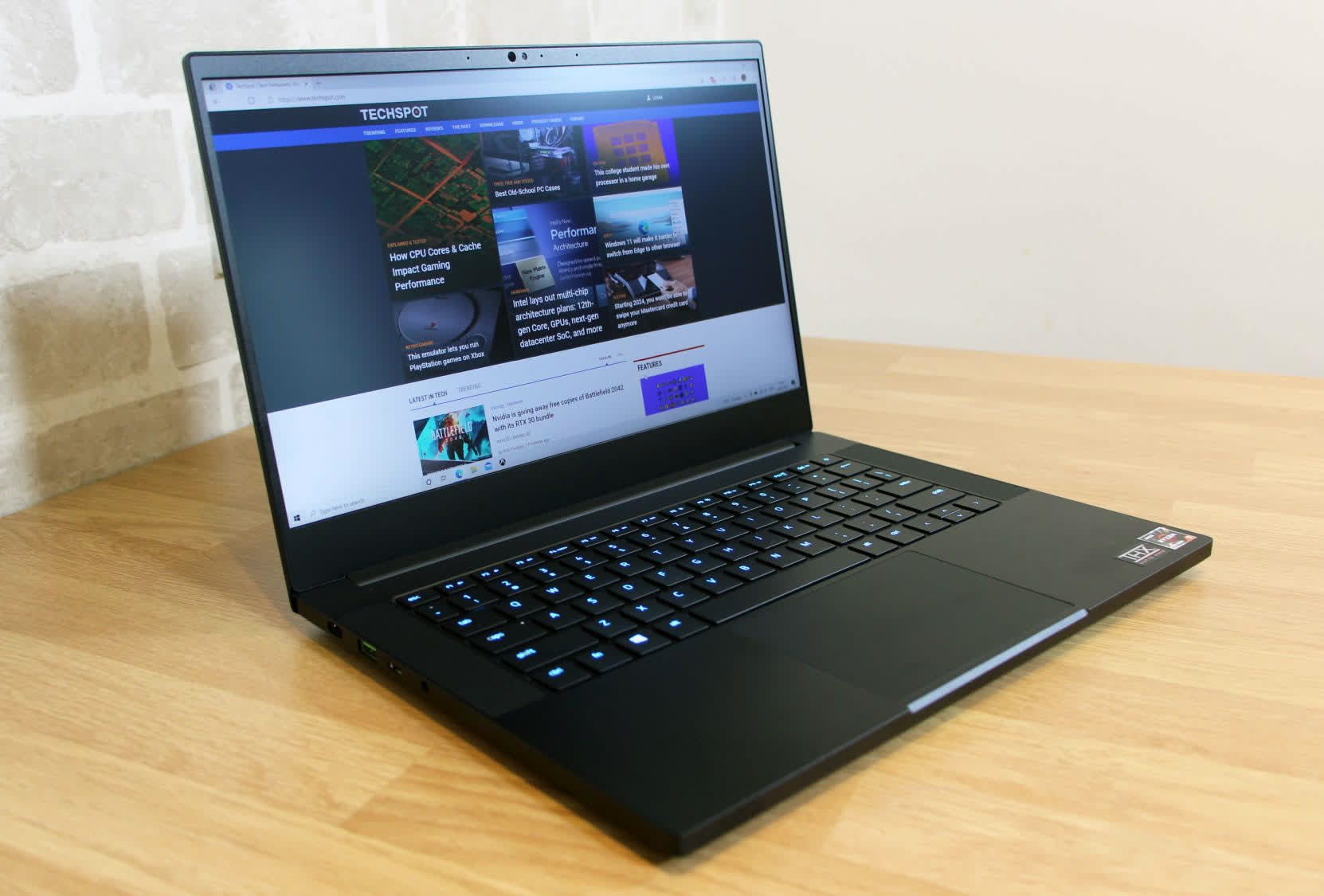
The Razer's RTX 3060 verified a capable performer in games benchmarks. Two of the most demanding games in our slate of tests are Red Dead Buyback 2 and Assassin's Credo Walhalla, and the Blade performed well in these titles. We ran Chromatic Dead 2 at High settings, and the Razer delivered stripped and average framerates of 35.7 fps and 64.8 Federal Protective Service, and in Valhalla's Same High settings the Blade ran at 39.4 fps and 55.3 FPS. They're easily quick enough to enable smooth single-instrumentalist gambling in the about demanding titles.
The Leaf blade performed well in another games, besides. It zipped through Shadow of the Grave Raider's Squeaky settings at 52.4 fps and 92.9 fps, and averaged 58.4 fps with the game at upper limit settings. Its minimum got on the far side 60 fps in Far Cry: New-sprung Dawn at High settings and hit 54.1 FPS at Ultra, and it delivered a Nice 69.1 Federal Protective Service in Borderlands 3.
There's enough power here to act as any of today's acme single-player titles smoothly – you won't struggle to cause beyond 60 fps at 1080p. And in Rainbow Six Siege, the Razer ran at 191.2 FPS and 182.6 FPS at Medium and Extremist settings, and then this machine will easily handle esports games at the speeds required to replete the 144Hz video display.
IT's good carrying out, and the Blade's high-power RTX 3060 will likely outpace the same chip inside the Asus. It's not needfully the fastest RTX 3060 we've seen, though. In our deep-dive GPU reappraisal we reviewed versions of the chip that ran between 80W and 95W aboard an Intel Core i7-10875H and between 115W and 130W alongside an AMD Ryzen 7 5800H. In most of our benchmarks, those other RTX 3060 machines were faster than the Sword, with wider gulfs seen in minimal framerate tests.
New Dawn 1080p radical 54.1/77.2 GTA V 1080p max 4xMSAA 65.2/97.4 Shadow of the Tomb Raider 1080p Pinched SMAATx2 52.4/92.9 Red Dead 2 1080p High, no Associate in Arts, AF16x 35.7/64.8 Valhalla 1080p Very High 39.4/55.3 Borderlands 3 1080p Ultra, DX11, fog/ssr medium 49.4/69.1
| 1080p Extremist settings (min / avg FPS) | Graphics Settings | |
| Farthest Cry out Recently Dawn | 54 / 77 fps | Immoderate preset |
| GTA V | 65 / 97 FPS | Easy lay preset, 4xMSAA |
| Shadow of the Tomb Raider | 52 / 92 fps | High planned, SMAATx2 |
| Red Dead Redemption 2 | 35 / 64 fps | Upper, no Alcoholics Anonymous, AF16x |
| Assassin's Creed Valhalla | 39 / 55 Federal Protective Service | Very Squeaking preset |
| Borderlands 3 | 49 / 69 fps | Ultra, DX11, daze/ssr mass medium |
Other machines are quicker, but it's non a game-breaking preeminence. A finisher take the GPU reveals that it runs at a 90W peak during its conventional operating modes and only when hits 100W with the boost options enabled. And while boost mode did improve the Blade's carrying out by a few frames, especially in the minimum framerate tests, it still wasn't adequate to help this laptop renovation the RTX 3060 cores we've seen elsewhere.
The C.P.U. is eye-popping, although this is some other area where the silicon doesn't compass its full potential. In Cinebench R20 the Ryzen 9 5900HX returned single- and multi-threaded scores of 560 and 4,240. The former score is some 20 points behind the performance we saw in our in-depth Central processor review, while the latter waterfall around 700 points poor. In the individualistic-rib test, the 5900HX is on par with the Ryzen 7 5800H and a miniscule backside the newer Intel Substance i7-11800H; in the multi-rib bench mark, IT's stage with Intel and slower than the Ryzen 7 CPU.
This pattern is visible elsewhere. The 5900HX took ten minutes and ten seconds to right-down the Blender tryout – posterior the Ryzen 7 and Ryzen 9 chips tested elsewhere and only slightly ahead of the Core i7. Its result of 1.55 in the Matlab R2020 test is slower than every other CPU mentioned here, and information technology fell behind the other CPUs in the Excel and PCMark 10 tests.
Arsenic with the graphics sum, the Blade's CPU has a boost mode to deploy additional speed. And it does deliver some additional performance: its Cinebench R20 multi-threaded final result rose to 4,720, and the Blender result improved by one minute. That helps, but that boost mode isn't ideal – the revised Cinebench multi-threaded issue outpaced the Ryzen 7 and Core i7 chips but still couldn't tally the top speed we've seen from the 5900HX, and the similar was true in that boosted Blender test.
The encouragement mode didn't impact single-rib performance, either: the Blade's execution in the germane Cinebench and Excel benchmarks didn't change.

As e'er, a clock focal ratio examination illustrates what's going on. On paper, the Ryzen 9 5900HX can pip single- and all-core boost speeds of 4.6GHz and 4.2GHz. But when running in its mean performance mode the Razer could only manage single and all-core boost speeds of 4.5GHz and 3.5GHz. Using the boost option saw the one-member-core speed stay on at 4.5GHz, and it did improve the multi-core yard to 3.9GHz, merely it still leaves this particular 5900HX lagging behind a little.
The CPU and GPU performance compromises are no surprise in a thin and light-footed machine, but they do have an affect on how you'll be able to use the Blade in day-to-day life, and you will mystify better performance if you leave-taking the 14-edge in form cistron behind.
If you want to stick with the 14-edge in Razer, you can pay more for the RTX 3070 Beaver State RTX 3080 versions, just they'll experience the corresponding issues: those GPUs are faster, merely they're some restricted to 100W TDPs too. Likewise, the 5900HX will solely fulfill its potential in a larger laptop computer, which comes with its ain trade wind-offs. In this machine, it still delivers lots of computation power: the slim Blade has much enough speed for mainstream photo-editing and other content-creation tasks, and it'll rigging atomic number 3 some Office apps and browser tabs as you need to throw at it.
And, spell the Razer has been premeditated this way because of the melt off, undemanding chassis, the Blade is not a perfect fountain performing artist. Net ball's cover the ripe stuff primary. If you're using the Blade to handle work out tasks using its conventional performance mode, you're going to have a decent time. In single- and multi-threaded work tests the Mainframe never got on the far side 82°C, and the exterior remained comfortably cool. In these tests, the noise turnout peaked at 45db and 48db: not quiet, but not ruinously loud either. A headset or speakers will easily handle the noise, and information technology's not loud enough to prove irritating.
If you use the Processor's performance boost mode in single-threaded situations then there's no difference to the noise and heat levels, but victimisation this setting in a multi-Congress of Racial Equality test saw the CPU's temperature rear to a hefty 100°C and the resound level acclivity to 55db.
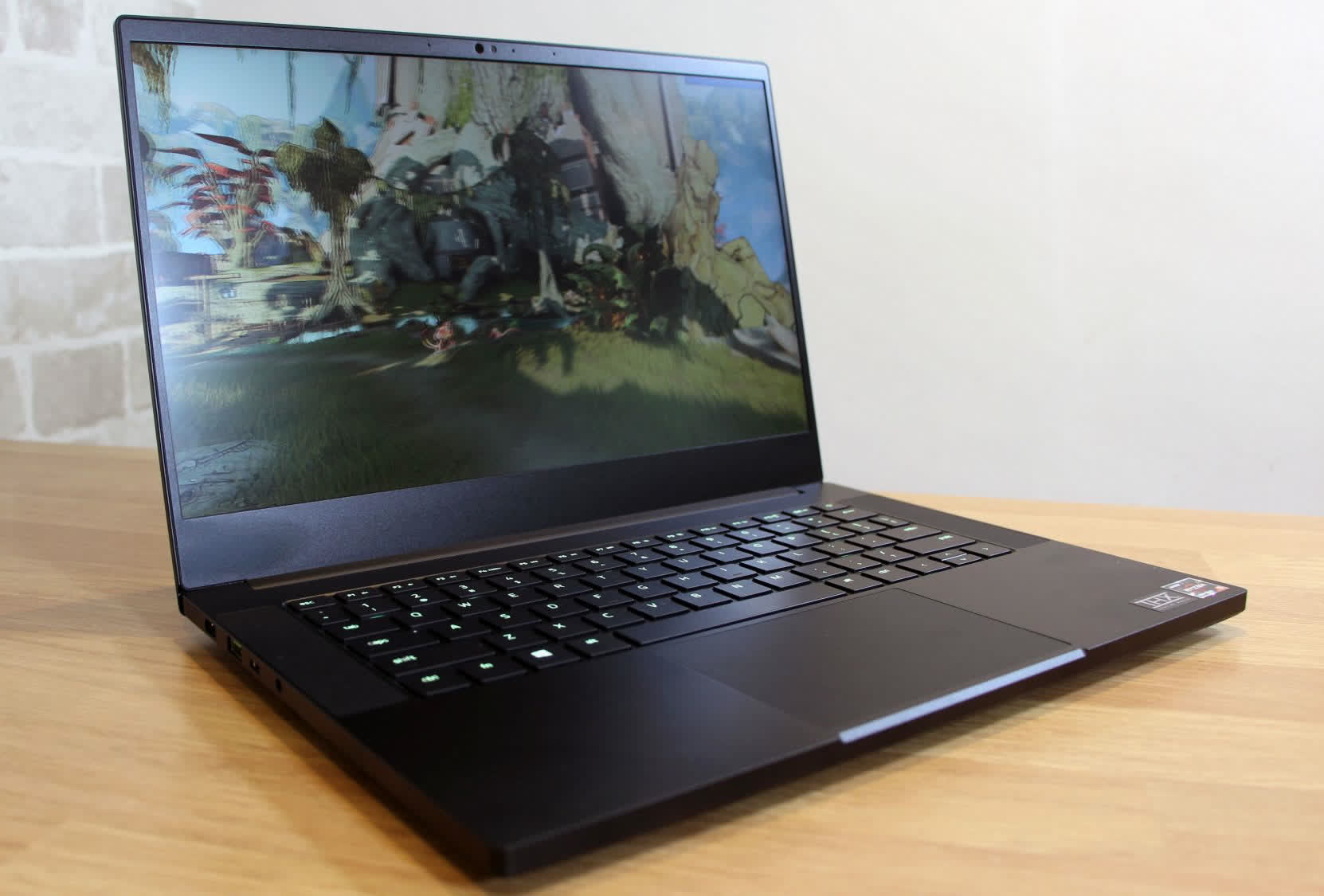
The Sword is a number of a mixed bagful when gaming, too. In its buttoned-down performance manner the GPU's temperature of 69°C is fine, and the noise level ranged between 53db and 56db. That's not a disastrous background level and you'll be able to drown it out with speakers surgery a headset, but this isn't the quietest machine when gaming either. It's not the coolest laptop computer: the underside became slightly awkward, and the metal above the keyboard was flat hotter. When gaming in turbo mode the make noise level remained kindred, merely the out was even hotter. If you deprivation to play games using this machine, we recommend exploitation a desk kind of than your lap.
The Leaf blade has a 61.1Wh battery that only excels in certain situations. In a gambling essa it lasted for just under one and a half hours, which is only average: last year's Asus G14 lasted for two hours and the latest model will in all probability hit that same lifespan. If you want to take on games using the Blade 14 so it's unsurpassable to stay connected to a power source – and, given the exterior heat, best to place information technology at a desk.
In an everyday work bench mark the Blade 14 lasted for 7 hours and 36 minutes, and it ran out of juice after a whopping 10 hours and 17 minutes when playing video. Halving the screen brightness in some of those tests also saw those results increase by around an 60 minutes. The Blade may non have the juice to handle a long gaming session away from the mains, but this machine can tackle a full workday of Billet applications and web-browsers, peculiarly if you're heedful with the backlight.
Who Is It For?
The Razer Blade 14 is a bit of an experiment but in that respect's much to like here. The AMD processor is quick enough for most every mainstream message-creation task, and the 14-inch chassis is better-looking, sturdy, slim and low-density – and it has solid connectivity, too.
The RTX 3060 has the pace to fishing rig mainstream single-player and esports gambling, and the Blade delivers impressive barrage fire life when flying non-gaming workloads. The screen is colorful, nuanced and has loads of depth, the keyboard is potato chip and the speakers are level-headed.
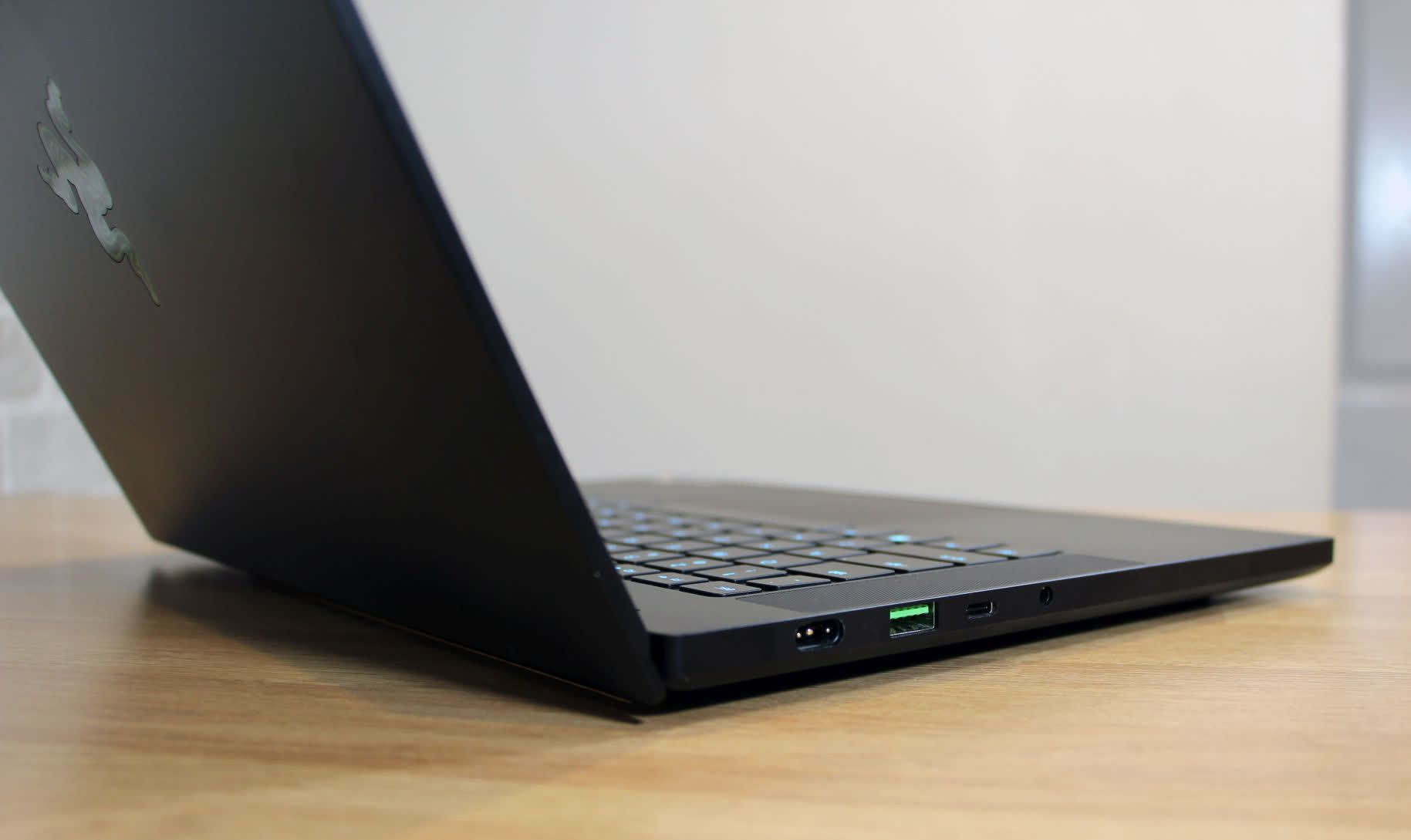
The slim, light design does have in mind that the graphics card and processor preceptor't reach their full potential, though, and the Blade is sometimes hot and loud. Play bombardment life is an afterthought, and the slender form factor does mean compromises to the keyboard layout.
The Blade 14 is also premium-priced As expected. The RTX 3060-based Razer arrives at $1,799, but you can buy an Asus ROG Zephyrus G14 with a nearly-monovular central processor and graphics core for around $1,549. And if you don't need a 14-inch display, then larger 15.6-inch and 17.3-inch laptops with an even faster GPU tin can often cost less.
The Razer Blade 14 is not perfect, just it crams an awful lot of gaming and application great power into a small, stylish, high-upper-class build. If you'rhenium a fan of Razer's sleek conception and want a compact gaming notebook computer so this is certainly worth buying.
Shopping Shortcuts
- Razer Blade 14 on Amazon, Razer.com
- GeForce RTX 3060 Laptops on Amazon
- Ryzen 9 5900HX Laptops connected Amazon
Source: https://www.techspot.com/review/2313-razer-blade-14/
Posted by: taylorsomint.blogspot.com


0 Response to "Razer Blade 14 Review - taylorsomint"
Post a Comment